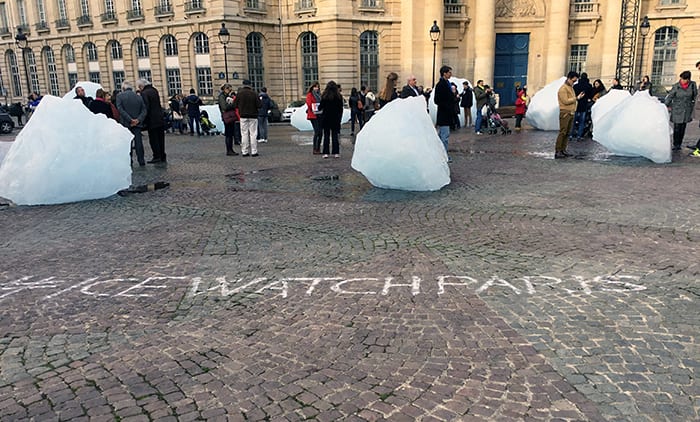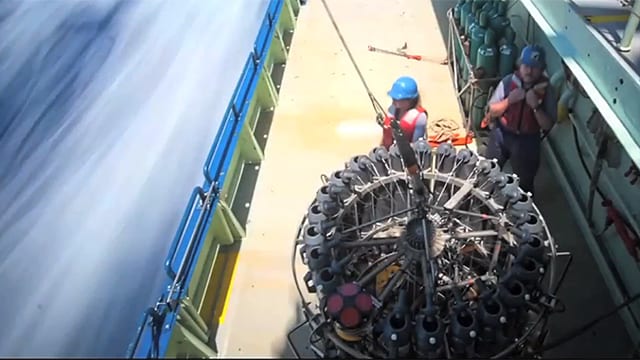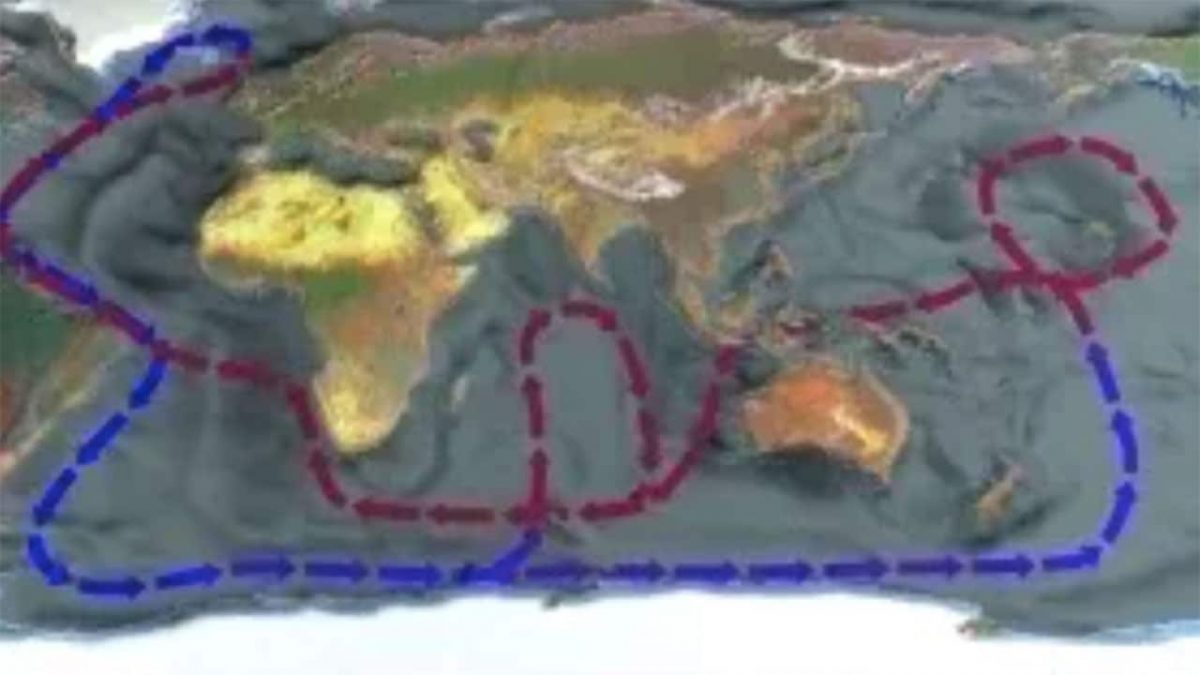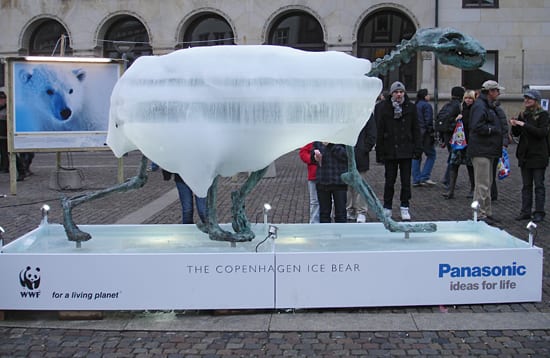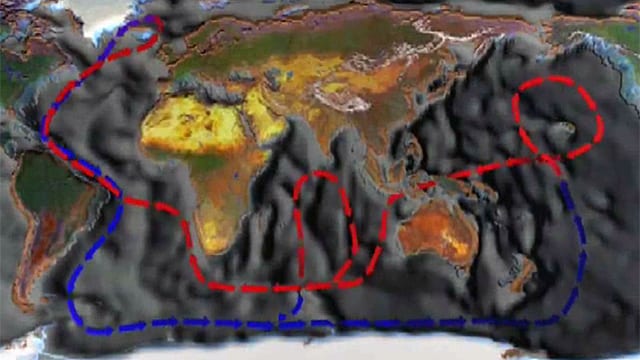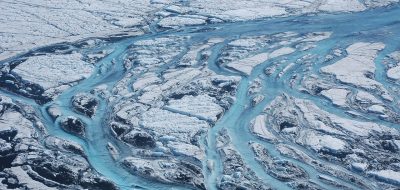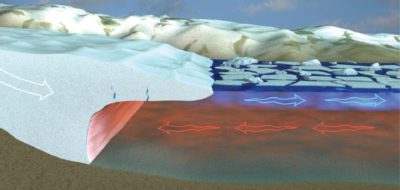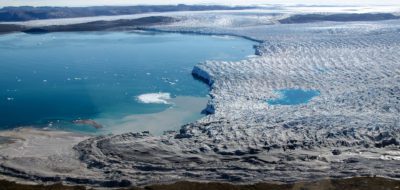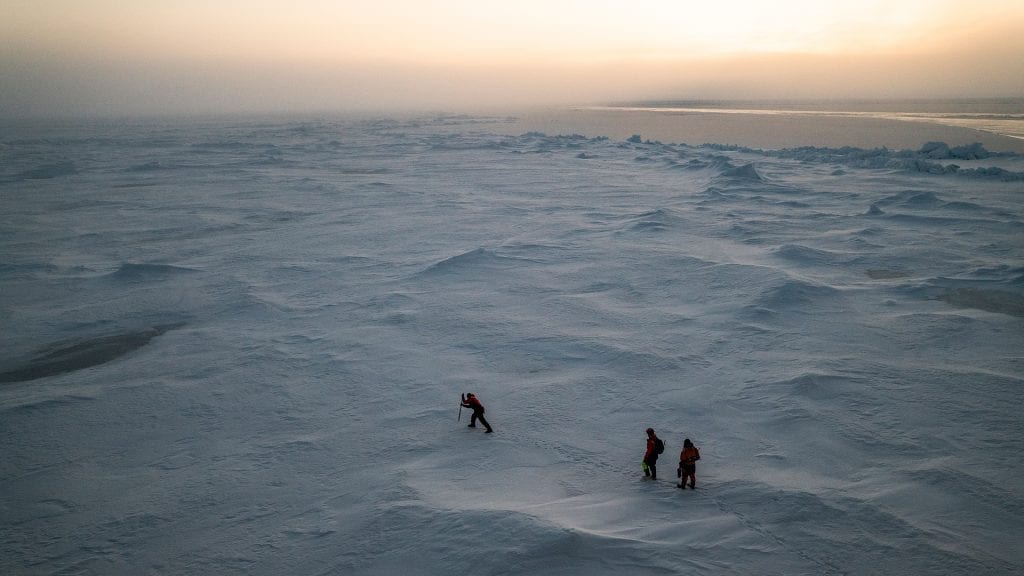
Several intrepid explorers trek out onto the thick Arctic ice sheet to get ice cores that will give them insights into large-scale shifts due to climate change. (Photo by © Luis Lamar)
The May 28 release of the science-fiction movie The Day After Tomorrow has raised awareness of global warming and fictionalized the pace and effects of resulting abrupt climate change. To help distinguish science from science fiction, here is a summary of some points raised by the movie and commentary edited by William Curry, director of the Ocean and Climate Change Institute, and WHOI scientists Karen Bice, Ilya Buynevich, Sarah Das, Jeff Donnelly, and Ray Schmitt.
Q.The abrupt climate change in the movie seems to happen in a matter of weeks. Is this possible?
A. No. While the atmosphere warms and cools on the scale of hours (the morning is cooler than mid-day, for example) a change in ocean circulation (Figure 1) that would trigger a climate effect would take place on the scale of decades at the very fastest. The ocean, because of its immense volume and the slow rate at which it gains and loses heat, cannot physically change as quickly as depicted in the movie. Ice sheets and glaciers, also because of their immense mass, cannot melt away in a matter of weeks. It is worth keeping in mind that an "abrupt" climate change, which may take place over a decade, is abrupt from a geologic perspective, in which many phenomena take place on the time scales of hundreds of thousands to millions of years.
The abrupt climate change scenario most scientists are investigating involves a regional cooling in the area of the North Atlantic, not a global cooling. It would not result in a global ice age, like the one in which glaciers reached as far south as Ohio and Long Island, New York about 18,000 years ago. How much cooling may take place depends on when the ocean circulation changes. If it changes within the next 50 years, winters may be colder and more severe than if ocean circulation changes 50 to 100 years from now, when continued global warming will outpace effects of regional cooling.
Q. In the movie, a giant hurricane descends from the Arctic, freezing people with -150° F wind. Is this possible?
A. No. Hurricanes, by definition, gather strength from heat and moisture from warm ocean waters. They lose strength over land, and when the air or water temperature falls below tropical levels. Hurricanes cannot form in the Arctic. In addition, no storm could grow large enough to cover the entire northern hemisphere. Storms and strong winds form because of a gradient in atmospheric pressure. You can have a strong gradient (and therefore a strong wind) over only relatively small distances. It cannot be stormy everywhere at once.
In addition, a chill of minus 150° F is colder than any temperature so far observed in nature. The lowest recorded temperature on Earth was minus 128.6° F at Vostock, Antarctica on July 21,1983. The coldest recorded temperature in North America was minus 81.4° F at Snag in the Yukon Territory, on February 3, 1947.
Q. Is a 40-foot storm surge possible in New York?
A. A storm surge does not arrive as a single, giant wave but typically as a rise in water over a period of a few hours. The wave depicted in the movie is more like a tsunami, a large wave that results from an earthquake or submarine landslide.
Storm surges along the coast are caused by a combination of the low pressure of a storm literally lifting up the surface of the ocean, and onshore winds pushing water against the land. The low pressure effect due to a hurricane adds only a few feet to a storm surge, and a storm approaching from the north would have the wrong wind direction to create a surge in Manhattan. It would tend to move the surge out to sea, not landward.
The last two most intense storms to hit the Northeast—the hurricane of 1821 and the Hurricane of 1938, which were about the same intensity—produced storm surges of about 10 feet. Models produced by the National Oceanic and Atmospheric Administration indicate that storm surge of about 20 feet is possible in New York given an intense hurricane strike in northern New Jersey.
Q. If Antarctic ice breaks off in chunks a hundred miles across (or bigger), can that cause a tidal wave, or a sudden rise in sea level?
A.Earthquakes in or near the ocean and underwater landslides are the most common causes of tidal waves—more properly called tsunamis. They have also been caused by a sudden, catastrophic collapse of ice, mostly likely from calving of glaciers. These tsunamis tend to be localized events. The likelihood of a tsunami from a collapse of Antarctic ice reaching New York is extremely remote. Many landmasses in the southern hemisphere would likely block any tsunami originating in Antarctica from reaching New York. Ice shelves (in contrast to ice sheets) are already floating in the ocean, so when they break off—as did a chunk of Antarctica’s Larsen B ice shelf the size of Rhode Island in 2002—they do not cause tsunamis or any increase in sea level. (see: https://nsidc.org/news/newsroom/larsen_B/index.html)
Q. Does global warming cause a rise in sea level?
A.Yes. There are two modes of sea level rise: rapid and gradual. A gradual rise in sea level has been occurring for the last 5,000 years. Global warming accelerates this rise by converting land ice (glaciers) to water and adding it to the oceans. Global warming also causes water to expand in volume as it warms. This thermal expansion of the oceans results in increasing sea level. The effect of thermal expansion on sea level is thought to be more pronounced in mid- to high latitudes than nearer the tropics.
On average, sea level is rising today at more than 0.08 inches (2 millimeters) per year and if the Intergovernmental Panel on Climate Change is correct, that rate may approach 0.2 to 0.32 inches (5 to 8 millimeters) per year by 2100—the fastest sea level rise in the last 7,000 years.
Some scientists have suggested that continued global warming could lead to a collapse of the West Antarctic ice sheet, which covers an area of sea and land of about 770,000 square miles, or about the size of California and Alaska combined. If the sheet were to melt—which would take thousands of years at present rates of global warming—sea level is estimated to rise by up to 20 feet. How quickly this rise would happen is uncertain. Many scientists consider melting "rapid" if changes are measurable on the scale of decades (see: http://www.nsf.gov/pubs/1996/ nstc96rp/sb4.htm). The West Antarctic Ice Sheet is thought to have melted during the last interglacial, when earth's climate was much like today and global sea level was 18 to 20 feet higher than it is today (Figure 2).
A lot of work is being directed at understanding the Greenland Ice Sheet today, where dramatic changes have been seen in the past few decades (thinning, speeding-up of glaciers, and increased melting). Many of the fast-moving regions of the West Antarctic Ice Sheet, on the other hand, appear to be slowing down, and temperatures have actually been cooling in that part of Antarctica.
Q. Still, is there scientific evidence that climate change can take place within the span of a decade?
A. Abrupt climate change—taking place over the interval of a decade—is considered possible because several times in the past, discharges of freshwater from melting ice appear to have changed ocean circulation and thus climate. Global warming today is melting ice and increasing precipitation and run-off at high latitudes, which is contributing to North Atlantic waters becoming fresher (less salty).
However, models of the ocean disagree on whether this will disrupt the North Atlantic Current. No models predict an abrupt shutdown in North Atlantic circulation in the near future. Some predict an intensified current and accelerated warming instead of cooling. Even if the North Atlantic Current is deflected by a thickening lens of fresh water, only a modest change in circulation is predicted by other models. The degree of this change and its climate effect depend on when the ocean circulation is interrupted. If it happens in less than 50 years or so, we might anticipate a modest regional cooling. If it happens after 50 years or more, the cooling may be enough to mitigate the effects of increasing global warming in the North Atlantic region but would not result in widespread cooling compared to today’s climate.
Present day model predictions are sensitive to their treatment of oceanic mixing processes, an area of active research that promises substantial progress in the next decade. Similarly, we are just beginning to deploy the instruments needed to understand the ongoing changes in the oceanic water cycle that will have a climate effect. While the paleoclimatic record has proven the importance of the ocean to the climate system (see: WHOI News Release, "Rate of Ocean Circulation Directly Linked to Abrupt Climate Change in North Atlantic Region"), we still have much to learn about the workings of the vast, unexplored and complex ocean before we can make reliable climate predictions
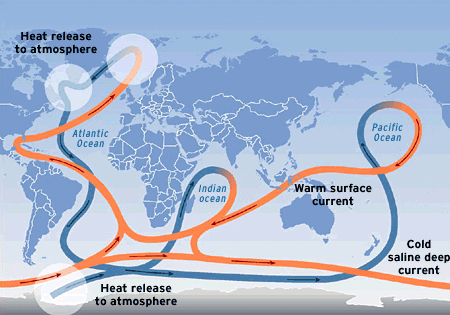
Figure 1: The global ocean circulation system, often called the Ocean Conveyor, transports heat throughout the planet. Orange sections represent warm surface currents; blue represents deep cold currents. Freshening of the North Atlantic may cause a deflection of north-flowing warm currents, possibly causing a regional cooling over the North Atlantic, in western Europe, and eastern North America. (From the Intergovernmental Panel on Climate Change)
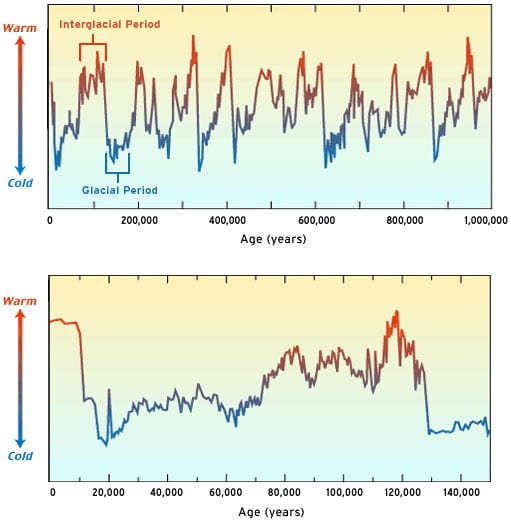
Earth's climate is anything but stable, with dramatic swings in cooling and warming over the past 1 million years (top) and past 140,000 years (bottom). This plot of climate change over time is based on chemical information collected from shells of organisms preserved in deep-sea sediments. We are currently in a warm (red) period, called an interglacial. Sea level rises as the climate warms and falls as the climate cools, as more water is locked up in ice on land. During the last interglacial 120,000 years ago, sea level was 18 to 20 feet higher than it is today. (Illustration by Jack Cook, WHOI)

